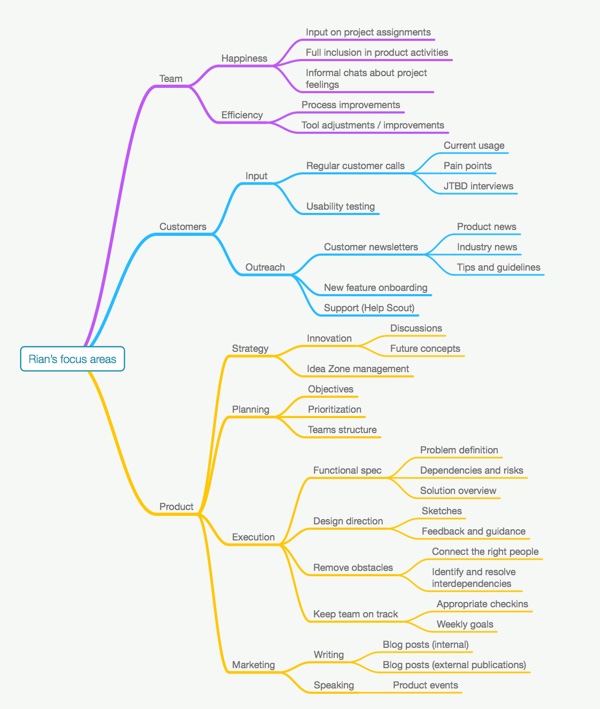In a recent blog post about our 4-day work week experiment at Wildbit, Natalie (our CEO) wrote about some things we’re doing to focus our jobs a bit better. The example she used in that post is the exercise I went through to clarify my role as product manager, so I thought it would be interesting to talk about that process a little bit more.
If you’re in a position where you’re a little unsure about the focus of your role, or what exactly you should be working on day-to-day, you might find the process I describe here useful to help you figure it all out.
What exactly would you say you do here?
Even though no one can quite agree on how to define the role of the product manager (but you should totally read my book about that), I think we’re all in agreement that it requires lots of different kinds of tasks—which results in lots of context switching. This means that focus is a constant struggle for PMs. Yes, this is true for many roles, but it is especially true for PMs since the ability to switch between different tasks is so central to what we do to help keep things moving.
The issue is not just that switching contexts all the time is hard, it’s also that knowing what to switch to next can be such a challenge. PM minds are in a constant state of prioritization and reprioritization.
It’s with this as background that Natalie and I had a very long 1:1 a few months ago as we realized I’d drifted away slightly from what my core focus at Postmark needs to be. As we got our development process nailed down, that part of the business needed less involvement from me so I started to spend more time on things like metrics frameworks and improving our prioritization methods. Because that’s just what PMs do—we look for things to fix, and then we jump in.
I had a huge realization that I was starting to spend time on the wrong things when Natalie said to me,
Rian, stop trying to turn us into a big company.
That is arguably the most important thing she has ever told me. Because that is exactly the path I was inadvertently going down. Process improvements aren’t bad, but at that time it was not what the team needed. So we got to work to find out what our team needs in our context and our culture.
Mapping a chaotic role into submission
Natalie encouraged me to go through an exercise she has gone through before. It involves creating a detailed mind map of all the things you do during a particular week, and then using that to identify and prioritize your focus areas. I jumped into MindNode, and after a couple of weeks of working on it with Natalie, we came up with the following map of what my focus areas should be:

It looks all neat and sensible now, but it’s worth mentioning that the process was messy for a quite a while. My natural propensity for order made me want to start at the left with the big buckets of my role, and then expand to the right into more and more detail. In practice it didn’t work like that at all. I ended up starting with cataloging some of the mid-level tasks I spend my time on (such as Regular customer calls and Prioritization). With those things as a starting point I then branched out—sometimes to the right (Customer calls leads to defining that we should talk about Pain points), and sometimes to the left (Prioritization leads back to a larger Planning bucket).
I also ended up deleting a bunch of stuff on the far right during my discussions with Natalie. Specifically, we started to see where I was doing too much of the things that the marketing team was doing already. Once we had a visual picture it was easy to see where I need to scale back, and which areas need more definition.
Bringing order to day-to-day tasks
Once this was done, as I stared at the map for a while, I wondered if I could somehow use it to make my days a feel a little less arbitrary. So I took it one step further and simplified my role as a progression from Listen to Think to Act:

This model now helps me prioritize my days when it comes down to deciding what to work on. If I’m in Listen mode I’m more likely to spend most of the day on calls and discussions with the team and customers. Other days are primarily focused on Act so I tend to spend a bunch of time in JIRA or Basecamp creating the content we need on projects.
This has helped a lot with the scattered feeling I often got when switching contexts too much. I still switch between tasks, but keeping it in the same “family” helps so much with focus and productivity.
In summary—I think you should do this
Creating this mind map has been an eye-opening experience for me. It not only helped me to clarify what I should work on (and when), it also constantly ensures that Natalie and I are on the same page about what I should be spending my time on. This is especially important as a remote employee where we don’t catch up all the time about what I spend my time on.
Natalie and I look at my focus areas together and discuss any changes we might need to make. But other than that, I feel confident that I’m doing the stuff that’s most important for our team, our customers, and the business. I like that feeling a lot.